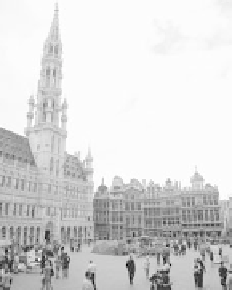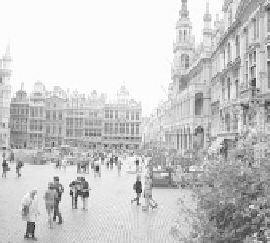Travel Reference
In-Depth Information
The Grand place: center of Brussels
Face the Town Hall, with your back to the King's House. You're
facing roughly southwest. The TI is one block behind you, and
“restaurant row” is another block beyond that. To your right,
a block away, catch a glimpse of the Bourse building (with
buses, taxis, cafés). The Upper Town is to your left, rising up
the hill beyond the Central Station. Over your left shoulder a
few blocks away is St. Michael's Cathedral. And most impor-
tant? The
Manneken-Pis
is three blocks ahead, down the
street that runs along the left side of the Town Hall.
(not Seine) River, which today is completely bricked over. The river
crossed the main road from Köln to Bruges.
Pan the square to get oriented. The
Town Hall
(Hôtel de
Ville) dominates the square with
its 300-foot-tall tower, topped by a
golden statue of St. Michael slay-
ing a devil (skippable interior; see
page 385 for tour times if you're
interested). This was where the city
council met to rule this free trading
town. Brussels proudly maintained
its self-governing independence
while dukes, kings, and clergymen
ruled much of Europe. These days,
the Town Hall hosts weddings—
Crown Prince Philippe got married
here in 1999. (The Belgian government demands that all marriages
first be performed in simple civil ceremonies.)
Opposite the Town Hall is the impressive, gray
King's House
(Maison du Roi), used by the Habsburg kings not as a house, but
as an administrative center. Rebuilt in the 1890s, it's a stately and
prickly Neo-Gothic building. Inside is the mildly interesting City
Museum (described on page 400).
The fancy sma l ler buildings
giving the square its uniquely grand
medieval character are former
guild
halls
(now mostly shops and restau-
rants), their impressive gabled roofs
topped with statues. Once the home
offices for the town's different profes-
sions (bakers, brewers, tanners, and
Manneken-Pis-
corkscrew-makers),
they all date from shortly after





















